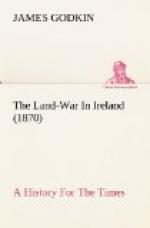’Notwithstanding a basis of manly, honest, and often generous qualities, the common character of all the uneducated and unelevated classes of the English labouring population includes, as marked and obvious features, improvidence, distrust of their superiors, discontent at their social position, and a predominant passion for gross animal gratification. Of this general character we regard the rude, heavy, unhopeful English peasant, who knows no indulgence or relaxation but that of the ale-house, and lives equally without content and without ambition, as affording the fundamental type, which, like all other things English, possesses a marked individuality. It differs decidedly from the Irish type of peasant degradation. Something of this may be due to the effect of race. The Kelt and the Saxon may be expected to differ. Yet we think but little stress is to be laid upon this. There is, probably, much more Keltic blood in the southern and western counties of England, and, also, more Saxon blood in some of the southern and even western parts of Ireland, than has been generally supposed. We apprehend that a Saxon population, under the same conditions as the southern and western Irish peasantry, would have grown up into very much the same sort of people as the Irish have been; while a Keltic population, exposed to the same influences, through successive generations, as the midland and southern peasantry of England, would not have been essentially different at the present day from the actual cultivators of the soil.
’The Irish peasant is poorer and yet more reckless than the Englishman; but he is not so sullen or so spiritless. His body is not so muscular or so strongly-set as that of the Anglo-Saxon husbandman, on whose frame the hard and unintermitted toil of thirty generations has stamped its unmistakable impress, and, correspondently, he is a less persevering and less vigorous labourer; but, as a general rule, his stature is taller and his step far more free and elastic than that of the sturdy but slow and stunted labourer of our southern counties. There are wild mountainous districts of the west, indeed, in which the lowest type of the Irish peasantry is found, that must be taken as exceptions to our general statement; and as many from those regions cross the Channel to tramp through England in the complex character of mendicant labourers, no doubt some have received from them an impression as to the Irish peasantry very different from what our observations are intended to convey. But no one can have travelled through the south of Ireland without having noticed what we state. The Tipperary and Kilkenny peasantry are proverbially tall; Connemara has been famed for its “giants,” and many of both sexes throughout the south, are, spite of their rags, fine figures, and graceful in their movements. While looking at them, we have ceased to wonder at what has been regarded as no better than the arch-agitator’s blarney, when he spoke




